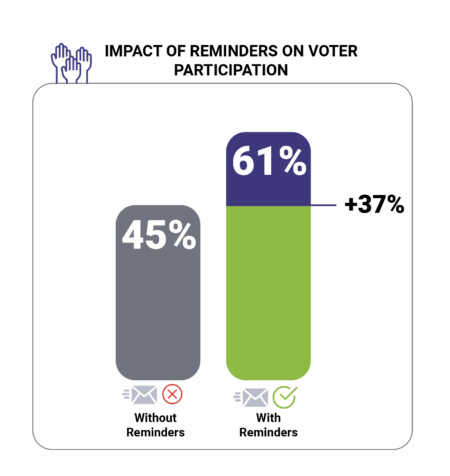In HOA and condo elections, voting reminders increase quorum by keeping the process top-of-mind for busy homeowners. The process of organizing elections for HOAs and condominiums extends beyond setting a date and notifying residents once. In today’s fast-paced environment, homeowners juggle multiple responsibilities, making it easy for them to overlook voting—particularly in elections that remain open for extended periods.
A 2024 analysis of HOA and condominium elections conducted through VotingPRO found that regular reminders can increase voter participation by up to 37%. However, reminders must be used strategically, as excessive notifications can lead to what is known as “notification fatigue.” Knowing how many reminders to send and when to send them is key to maximizing engagement without overwhelming voters.

The Necessity of Reminders in Elections
Findings indicate that a single election notice is often insufficient to ensure broad participation. Without consistent engagement, voter turnout declines as residents become preoccupied with daily obligations.
Elections conducted without reminders frequently faced the following challenges:
- Lower voter turnout, increasing the difficulty of reaching quorum.
- Missed deadlines, as homeowners forgot key voting dates.
- Reduced engagement, leading to less representative election outcomes.
How Voting Reminders Increase Quorum and Participation
The data from VotingPRO’s 2024 analysis established a clear link between reminder frequency and voter participation. Communities that implemented structured reminder strategies throughout the voting period observed an average 37% increase in participation compared to those that did not utilize reminders.
Key Factors Contributing to Higher Quorum
- Reinforcement of Voting Importance: Regular reminders helped maintain election visibility, preventing homeowners from overlooking their voting opportunity.
- Simplification of the Voting Process: Notifications containing direct links to the voting platform facilitated ease of access and encouraged participation.
- Creation of a Sense of Urgency: Strategically timed reminders—particularly those sent in the final hours of the voting period—proved highly effective in motivating last-minute voters.
Learn more about improving quorum through electronic voting in HOAs.
Balancing Reminder Frequency to Avoid Notification Fatigue
While reminders play a crucial role in boosting voter turnout, the analysis also identified a potential drawback: notification fatigue. If reminders are sent too frequently, voters may begin to ignore them or feel overwhelmed, reducing their overall impact.
For reminders to be effective, it is important to find a balance—sending enough to keep the election top-of-mind but not so many that they lose effectiveness. Timing, message clarity, and frequency must be carefully considered to ensure engagement remains high without frustrating homeowners.
The Role of Reminders in Different Election Timelines
The analysis further highlights that the impact of reminders varies based on the duration of the election:
🔹 For elections spanning several days or weeks, reminders served as a critical engagement tool, preventing the drop in participation that often follows the initial announcement.
🔹 For single-day elections, a well-timed reminder early in the day significantly influenced voter turnout, ensuring that more homeowners cast their votes before the deadline.
Conclusion: Strategic Reminders as a Tool for Increased Engagement
Strategic communication is essential—because, as 2024 data proves, voting reminders increase quorum and help communities meet their governance goals.
According to the Community Associations Institute, quorum requirements are critical in ensuring valid HOA elections and the 2024 findings reinforce the significance of well-timed reminders in voter engagement. Communities that implemented structured reminder strategies consistently experienced:
✅ Higher voter turnout
✅ Increased homeowner engagement
✅ A more efficient and representative election process
However, reminders must be carefully planned to maximize their impact without overwhelming voters. As HOAs and condominiums continue to refine their election processes, reminders remain a highly effective yet strategic tool for improving voter participation while ensuring a balanced approach to communication.

